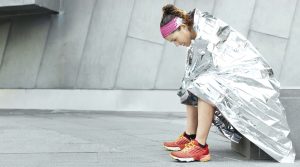The recent news that a six-year-old boy has completed a marathon in the US has sparked debate around what amount of running is safe for growing children. Here, soft-tissue therapist Anna Gardiner looks at the risks and provides advice for parents.
I love that my girls (Layla, 11, and Jasmine, nine) run. It’s rewarding, involves minimal organisation and is something we can do together. It was also something that was a constant during the Covid lockdowns, left over from the ‘time before’. Out went their clubs, walking to school two miles a day, school playtimes and tearing around the park with friends. Often during lockdown, the only time the girls exercised was the 2km a day they committed to.
But having seen children in my clinic suffering from overuse injuries, I worried whether increasing their running might be setting them up for injury.
What are the benefits of running for children?
Of course, before we worry about any potential harm that could come to young people from running, it’s important to consider the huge amount of good it can do them. The physical benefits of running and exercise for children are numerous and can last a lifetime. Recent studies suggest that, as well as improving cardiovascular health and warding off diseases like type 2 diabetes and conditions associated with excessive weight gain, weight-bearing exercise in early puberty is beneficial for long-term bone health.
Research has also shown that aerobic exercise can enhance brain plasticity (the brain’s ability to adapt and modify itself according to experiences and environment) and brain resilience (meaning the brain can better adapt to acute stress or trauma). Our hand-eye coordination, reaction speeds and the development of muscle fibres are established during childhood. The greater variety of physical activity carried out by children, research shows, the easier they find tasks and sports as adults.
Studies also support the link between exercise and positive mental health in children, with experts suggesting that running and exercise can help kids have a more positive outlook on life and help build their confidence. My daughters have also learned that consistent training results in personal bests – the important life less on that hard work pays off.
Exercise can even help manage anxiety and uncertainty in a changing world. A study published in the journal Pediatrics found that increased physical activity could prevent and treat childhood depression and manage other conditions.
What risks does running pose for children and young adults?
Still, when my daughter reminded me that finally she would be able to ‘race’ parkrun by herself when it reopened in the summer, it made me consider how we could incorporate that into her life, with athletics and running clubs already accounting for three sessions a week. I often see children and adolescents in my clinic with what are essentially overuse injuries.
Watching children and teenagers speeding around the 5K of our local parkrun, I wonder how often they’re running that sort of distance and pace. This is something to be mindful of at their ages. As much as we want to get them active – particularly as Sport England found that, at the height of lockdown back in May 2020, 31% of the children interviewed were doing less than 30 minutes of activity a day – it’s important to remember that their bodies are still growing. How do we gauge the balance between encouraging them to exercise to gain the physical and mental benefits running brings without overloading their growing bodies?
OVERTRAINING BURNOUT IS A DISTINCT POSSIBILITY FOR CHILDREN
Skeletal maturation happens over many years and is achieved when the growth plates have fused and adult bone shape and density have been attained,’ explains physiotherapist Claire Callaghan. So repetitive stress on the growth plates when they’re soft and still growing could cause pain and swelling, bone ‘bumps’ or, worse, stress fractures.‘Teenagers are also undergoing hormonal changes and rapid growth, as well as changes in body shape and weight,’ says Callaghan. These changes can affect the ability of the muscles and tendons to handle the load that impact activities place upon them, particularly where the tendons insert into the bone. Their bodies are already trying to adapt to normal growth changes, so they’re more vulnerable to further stresses. As a result, adolescents, particularly active children, are prone to medial tibial stress syndrome (aka shinsplints). Pain in the anterior knee or heel (either unilateral or bilateral) is also often brought about by excessive running, jumping or quick changes in direction.
Then there are musculoskeletal issues such as Osgood-Schlatter and Sever’s disease. The most common and adolescent-specific, Osgood-Schlatter (sometimes called osteochondrosis), occurs at the patellar tendon insertion site at the tibial tuberosity – essentially at the top of the shin and below the kneecap. This is where your young runner’s quadriceps attach via the tendon to the growth plate at the top of the shin bone. Repeated traction and force caused by frequent high impact in this area can create microvascular tears and inflammation, which presents as pain, swelling and/or a bone prominence.
WE DON’T WANT TO BREAK OUR YOUNG ATHLETES, BUT RATHER INSPIRE THEM TO LOVE THE SPORT
A review of Osgood-Schlatter data, published last year in the journal Current Opinion In Pediatrics, suggested that predisposing factors include the age of the child (12 to 15 for boys and eight to 12 for girls), sudden skeletal growth and poor flexibility of hamstrings and quadriceps. Pain is usually a dull ache at the top of the knee during running, jumping, kneeling or squatting, which subsides between minutes and hours after the activity stops.
Former Olympic long-distance runner turned running coach Liz Yelling, who
was coached from an early age, had mild Osgood-Schlatter. She remembers how her coach used to ask his athletes to measure their height weekly to ensure training was modified during a growth spurt. Treatments can range from rest (or at least modifying the inciting movement) or strength work, to ice or non-steroidal anti-inflammatory drugs. These should all be taken under the guidance of a professional. As Callaghan says, ‘If problems aren’t correctly diagnosed and treated, or if an adolescent pushes through pain, long-term issues can occur.’
Sever’s disease is also predominantly a young athlete’s condition (most common between the ages of nine and 12). It’s an inflammation caused by force and traction of the tendon at its insertion point at the calcaneus, or heel. Contributory factors are an increase in, or excessive, running and jumping, weak ankle dorsiflexion, ill-fitting shoes and running on hard surfaces – all at a time when a child is having growth spurts of both skeletal and soft-tissue structure. Treatment is similar – rest, ice and modification to training routines. But again, specialised guidance is strongly advised as it can be a recurring condition if left untreated. ‘It’s more important to look at load management and improving strength and conditioning if required,’ says sports podiatrist Matt Hart. ‘It’s not about footwear, but reducing load.’ Thats said, ‘shoes do need to fit well’, adds Callaghan, ‘as poor support can place too much force on growing bones’.
How to mitigate the risks
With children and adolescents more susceptible to these types of conditions, training smarter and making preventative, rather than reactive, changes are key. With all the benefits of running in youth and later life, we don’t want to discourage young runners. Fortunately, there are many things we can do to mitigate the risks.
1.Listen to your child and any complaints they may have of pain
It’s easy to brush off a child’s or adolescent’s complaints of discomfort or pain – if you’re a parent or carer who runs, you know first-hand about daily niggles. But it’s important to be alert to complaints, particularly if the discomfort is in the same place, either during an activity or after. Keeping a pain diary – not to encourage histrionics, but to be alert to patterns – can be useful. Then, if a professional’s help is sought, you’re armed with useful information for them to be able to quickly diagnose and treat the issue.
If a child constantly appears to have niggles, then they may be trying to tell you that they need a break. Running through pain isn’t good for adults or children and we don’t want to establish bad running habits. Keep in mind that it’s important to ‘listen between the lines’. Yelling offers this advice: ‘We don’t want to break our young athletes, but rather inspire them to love the sport and continue to be happy, active adults.’
2. Get help from an expert
If your child is becoming enthused by running and wants to run more frequently or competitively, then it’s ideal to have input from experts who can help nurture their running.
Sometimes, we’re not our offspring’s best role models. That can be a difficult pill to swallow, but they’re not mini adults and – although, aerobically, they’re capable of running further and longer – physically, they can’t do this to an extreme level without it being potentially detrimental to their musculoskeletal health over time. With the popularity of ultrarunning, virtual challenges and a trend edging towards the challenge of running further not faster, training with a club or a coach can remind us that our kids are just starting out and have many years of running in them.
Coaches at running or athletic youth clubs have had specific training on fostering healthy running practices. They can incorporate running games into sessions, helping to develop agility, speed and strength, rather than just linear movement. They’re also able to enhance the social aspect of an essentially individual sport and demonstrate how running with people can provide great motivation and encourage healthy competition.
3. Keep a diary of your child’s training and sporting activities
Overtraining burnout is a distinct possibility for children. Keeping a note of runs (and, indeed, other sports on a family calendar) for both yourself and your young runner is a great way of visualising the frequency and quality of training. Sometimes, it takes all their activities being written down to take a step back and consider whether they’re taking on too much.
In my clinic, I’ve seen young athletes whose parents only start to realise the degree to which they’re pushing their bodies when I ask them to go through a couple of weeks’ worth of activities. If the calendar flags that they’re overdoing things, we can then take steps
to modify the training or look at active rest, recovery or a period of cross training.
Overtraining was particularly noticeable when children went back to schools and clubs after the lockdowns, and people threw themselves back into ‘normal’ life. It was often overlooked that children were six months older, potentially in different stages of bone and muscle growth from where life was left off, and that going from minimal to maxed-out training doesn’t allow the body to adapt properly at any age, especially when still growing. ‘Children and teens aren’t “small adults” and can’t be treated as such,’ says Callaghan. ‘They need to gradually increase training so they don’t put too much pressure on growing joints and muscles.’
IF A CHILD CONSTANTLY HAS NIGGLES, THEN THEY MAY BE TRYING TO TELL YOU THAT THEY NEED A BREAK
4. Mix up their training
Mixing up their training miles to include a wide variety of surfaces is another sound strategy. Ideally, children would do most of their training on grass or at a track, because softer ground can reduce ground-reaction force. Playing other sports or doing other activities is also really important at this age. My eldest prefers running above any other sport, but trains at an athletics club where she also does jumping and throwing events. As is the case for adults, cross-training challenges children’s bodies in different ways, adding cardiovascular and musculoskeletal strength. Adapting soft tissue with different challenges also reduces the repetitive loads placed on the same joints, muscles and ligaments.
5. Consider a personalised training plan
There are recommended running mileage suggestions for different childhood ages, but each child is an individual, and generalised recommendations don’t factor in the different speeds at which their bodies mature. Plus, the two sexes have different biological maturation ages and are different in terms of hormones and musculoskeletal structures. So it’s key to look at the individual young runner, rather than set limits or targets based on generic advice. ‘As coaches, the athlete as a person should always come first,’ says Yelling. ‘We should focus on assisting optimal developmental processes, rather than focusing on results.’
6. Ensure your child is getting a healthy, balanced diet
It’s not all about training, though – diet and duvet time have roles to play. Ensuring children and adolescents eat a healthy, balanced diet – with a variety of food groups, plenty of fruit and veg, good protein sources and whole grains – is easier said than done, but it’s essential that, with growing bodies, they adequately fuel their runs and recovery. If too much is asked of soft tissue and bones without the essential ingredients for repair, sourced from food, bodies become fatigued and vulnerable to injuries.
7. …and plenty of sleep
The importance of sleep in promoting recovery and repair from training is well documented. A recent study published in the British Journal Of Sports Medicine found that teenagers need eight to 10 hours of quality shut-eye per night. Fitting in school work, after-school clubs, a social life and their running means kids often go to bed later than is ideal, so it’s important to notice when your child seems constantly fatigued and encourage them to take a session off and get an early night.
How else can we encourage healthy habits in our children?
Tips and strategies to help ensure our kids are all right…
- Make it fun. Tag, shuttle runs, relay races – they all develop fast- twitch fibres, encourage agility and build social relationships
- Add strength/conditioning. Introduce circuits as part of drills and warm-ups. Just body weight with a little bit of everything.
- Try geocaching. A great way to go a little further on mixed terrain with plenty of natural walk/recovery breaks.
- Run to feel. Encourage them not to push for times or pace in every session, but to listen to their bodies.
- Check clothes and shoes fit well. Keep an eye on growth spurts and ease off on training a little if you notice one is underway.
- Minimise pressure. Remember, we want them to have a healthy lifelong love for running and exercise.
Red flags
Look for these warning signs that your young runner maybe overdoing it and in danger of burnout or injury:
- Complaining of pain at the anterior knees, shins and heels
- Inflammation or swelling
- Moving stiffly or awkwardly in everyday life or when exercising
- Feeling consistently tired
- Running more than four times a week
- Pushing hard in every training session
- Reluctance to train
- Consistently disappointed with performance in sessions or races
Article Source: https://www.runnersworld.com/uk/health/a39925104/how-far-should-children-run/





